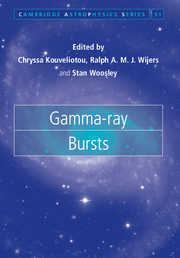Book contents
- Frontmatter
- Contents
- List of contributors
- Prologue
- 1 The discovery of the gamma-ray burst phenomenon
- 2 Instrumental principles
- 3 The BATSE era
- 4 The cosmological era
- 5 The Swift era
- 6 Discoveries enabled by multiwavelength afterglow observations of gamma-ray bursts
- 7 Prompt emission from gamma-ray bursts
- 8 Basic gamma-ray burst afterglows
- 9 The GRB–supernova connection
- 10 Models for gamma-ray burst progenitors and central engines
- 11 Jets and gamma-ray burst unification schemes
- 12 High-energy cosmic rays and neutrinos
- 13 Long gamma-ray burst host galaxies and their environments
- 14 Gamma-ray burst cosmology
- 15 Epilogue
- Indix
- Plate section
- References
12 - High-energy cosmic rays and neutrinos
Published online by Cambridge University Press: 05 December 2012
- Frontmatter
- Contents
- List of contributors
- Prologue
- 1 The discovery of the gamma-ray burst phenomenon
- 2 Instrumental principles
- 3 The BATSE era
- 4 The cosmological era
- 5 The Swift era
- 6 Discoveries enabled by multiwavelength afterglow observations of gamma-ray bursts
- 7 Prompt emission from gamma-ray bursts
- 8 Basic gamma-ray burst afterglows
- 9 The GRB–supernova connection
- 10 Models for gamma-ray burst progenitors and central engines
- 11 Jets and gamma-ray burst unification schemes
- 12 High-energy cosmic rays and neutrinos
- 13 Long gamma-ray burst host galaxies and their environments
- 14 Gamma-ray burst cosmology
- 15 Epilogue
- Indix
- Plate section
- References
Summary
Introduction
Cosmic rays (CRs) with energies exceeding ~5 × 1018 eV are termed Ultra High Energy cosmic rays (UHECRs). The (probably extragalactic) sources of these particles and their acceleration mechanisms are unknown and for many years have been the issue of much debate (e.g., Waxman 2004a, Berezinsky 2008, and references therein). The first part of this chapter, Section 12.2, describes the main constraints that are imposed by UHECR observations on the properties of candidate UHECR sources. In Section 12.2.7 it is shown that GRBs are the only known type of source that satisfy all constraints. The main open questions associated with the production of UHECRs are summarized in Section 12.2.8.
The GRB model for UHECR production makes testable predictions regarding the spec- trum and arrival direction distribution of UHECRs at the highest energies (Section 12.2.7). These predictions will, however, be difficult to test using even the largest available/planned UHECR detectors (see http://www.auger.org/). The challenges of identifying the UHECR sources, and of probing the physical mechanisms driving them, may be met by high-energy neutrino detectors (Halzen & Hooper 2002, Waxman 2005). The effort for addressing these challenges using high-energy neutrino “telescopes” is discussed in Section 12.3. It is shown that detectors, which are currently under construction, are expected to reach the effective mass required for the detection of high energy extragalactic neutrino sources, and may therefore play a key role in the near future in resolving the main open questions.
- Type
- Chapter
- Information
- Gamma-ray Bursts , pp. 251 - 268Publisher: Cambridge University PressPrint publication year: 2012



